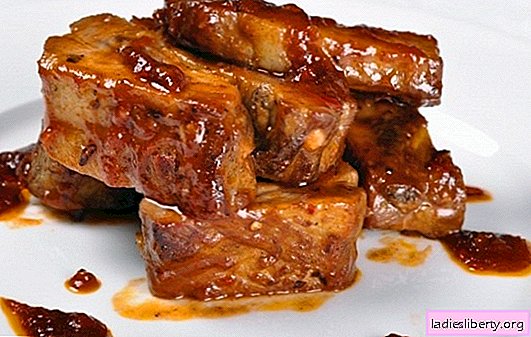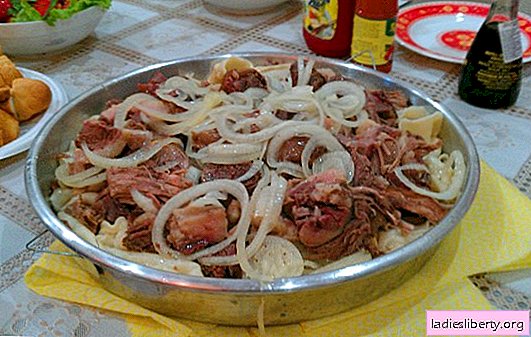
The cookbook of every housewife is complete without step-by-step recipes for your favorite cakes, and Napoleon is a classic for home confectioners. Unlike other famous desserts, it has several cooking options.
In fact, a simple design, a delicate creamy nutty taste is the perfect solution for a festive tea party. But even the recipe for a classic cake, over time, I want to improve, and since Napoleon was invented for a long time, then in its history there are many interesting cooking options that deserve attention. One of the reasons housewives are looking for new step-by-step recipes for the Napoleon cake is the products that make up it. For the first time, a cake recipe appeared at the royal court in 1912, on the occasion of the centenary of the Patriotic War of 1812. Since then, “Napoleon” has changed a lot, because in the twenty-first century technologies have appeared that make it possible to replace natural butter and milk with spread or margarine, as is done at enterprises that advertise their confectionery products, cheap and tasty.
What lies behind the cheapness of Napoleon, why homemade cake is always better - in a step-by-step recipe.
Step-by-step recipe for Napoleon cake - basic technological principles
The basis of the dessert is puff pastry and wet cream. As a rule, the impregnation process lasts about 10 hours - during this time the cake absorbs all the moisture and becomes very soft, and for those who like to “crunch” it takes only three hours from the moment the cake is assembled. The classic Napoleon must have at least 8-10 layers of thinly rolled chopped or puff pastry.
In the preparation of any dessert, an important point is the selection of products whose quality must be given special attention. Remember:
• Oil that accidentally absorbs odors after heat treatment will transfer them to the entire product. Do not use stale oil, even for making dough.
• All products for the preparation of puff pastry should be chilled. If the temperature is too low (less than 14 ° C), the cakes break during rolling, and the melted butter will make the dough stiff, "rubber".
• The cake is based on dough, which requires observing the temperature regime for its preparation, therefore the temperature in the room, when working with chilled products, should not exceed 18 ° С.
• The complexity of the preparation of the Napoleon cake lies in the rolling of cakes, but it is important to take this step responsibly, collecting all the patience. Layering of cakes determines the taste of the dessert, its delicate texture.
Separately, it is worth stopping at the choice of fat for dough and cream: butter, spread, margarine or vegetable oil. In those days, when the first Napoleon cake was made, there were only two types of fat from the four options that are used now: vegetable and butter. If we talk about the authenticity of the recipe for "Napoleon", then, definitely we need to make a choice in favor of butter. If you listen to the opinion of doctors and nutritionists, then margarine and spread are useless, to put it mildly, products, the use of which should be reduced to a minimum, due to the content of harmful cholesterol in these products.
The cream is mainly used with custard, but cake varieties with butter, cheese and cream creams are often found. In addition, various nuts or berries are added to it, sprinkled with powdered sugar and chocolate.
You will not find such a variety of ingredients in the production recipes of Napoleon, because the first rule that guides the confectionery enterprises that produce cakes is low cost and maximum profit. For the same reason, the Napoleon cake, bought in the confectionery department of the supermarket, does not deliver the expected pleasure. Margarine or spread, even with sugar and vanilla, can not replace a real creamy taste.
From this follows a simple conclusion: you can not argue with the classics.
Classic Napoleon - A Step-by-Step Cake Recipe
Ingredients:
Flour 760 g
Butter 650 g
Vinegar (9%) 15 ml
Salt 10 g
Sour cream (25%) 200 g
Milk 0.5 L
Vanillin 10 g
Granulated Sugar 250 g
Yolks 4 pcs.
Dietary eggs 2 pcs.
Walnut kernels 200 g
Cooking:
1. Separate 250 g from the indicated amount of oil, and cool this part, and leave the rest of the oil for the cream at room temperature.
2. Sift the flour onto the working table, separate two tablespoons for cooking custard, combine the rest of the flour with chilled butter and chop with a knife until smooth butter and flour crumbs.
3. Collect the resulting mixture, divide into 2 parts. Place one half in the refrigerator, and transfer the second to a bowl, make a deepening, pour sour cream, add vinegar and salt.
4. Knead the dough to a plastic state, but hurry up: the butter should not melt.
5. Divide the dough into 16 parts, roll the blanks into balls, put them in a plastic bag and put them in the refrigerator for a couple of hours.
6. While the dough is cooling, you can do cooking custard. Pour milk into a saucepan with a volume of 2.5 - 3.0 L, separating a small portion of the liquid (100-150 ml).
7. Put the pan on the stove and bring the milk to a boil, Combine 150 ml of cold milk with flour, mix the mixture with a whisk, wipe through a sieve to avoid lumps. Pour the resulting mixture into boiled milk, intensively mixing the whole mass with a whisk until thickened. Temporarily remove the pan from the stove.
8. Mash yolks and whole eggs with sugar, adding vanilla powder. Combine the resulting mass with brewed milk jelly, mix the cream again.
9. Warm the cream mass in a water bath before boiling. Stir the contents of the pan constantly with a whisk.
10. As soon as the first bubbles appear on the surface of the custard mass, remove the cream from the stove and let it cool to room temperature.
11. The softened oil remaining on the table, transfer to the bowl of the combine, whisk until white, gradually pouring the custard mixture. The readiness of the cream is indicated by the appearance of stable peaks on its surface.
12. Remove the chilled dough and butter and flour crumbs from the refrigerator. Sprinkle the surface of the table with flour, and begin to roll each ball individually. Choose the shape of future cake layers at random. The classic Napoleon cake is shaped as a rectangle or square.
13. Each portion of the dough must be rolled as thin as possible, to transparency. Then the layer is sprinkled with oily crumb, folded with an envelope, rolled out again to its previous size. Keep the dough cool and keep the fat from melting. Billets can be taken out of the refrigerator as needed, keeping part of them in the cold while working with the rest of the layers.
14. Bake rolled cakes on a baking sheet sprinkled with flour at 200 ° C. The oven must be warmed up to the required temperature in advance. Dough blanks, laying on a baking sheet, pierce with a fork or make cuts with a knife so that the layers do not deform during baking. Cakes are baked for no more than five minutes. During this time, it becomes slightly browned and brittle.
To prevent the cakes from breaking when assembling the cake, fold them in a stack on a baking sheet. Preheat the oven by turning on the combi steamer and steam the cooked foods for 10-15 minutes. Then transfer to a plastic bag and transfer to cold. In 7-8 hours they will become softer and more plastic.
15. Put the cakes one by one on the dish, greasing each of them with the prepared cream and pouring with nut crumbs. Level the surface, garnish with cream and nuts. Sprinkle the sides of the cake with the crumbs remaining after leveling the cakes.
16. Soak the finished cake in the refrigerator so that the cream is absorbed. After 10-12 hours, “Napoleon” will become soft, and it can be easily cut into triangles.
For a change, you can try other cream options in combination with cakes for Napoleon, for example, a lighter and less high-calorie cream-based cream and Mascarpone with fruits or berries.
Ingredients for Cream No. 2:
Mascarpone 750 g
Cream (not less than 33%) 250 ml
Sugar 200 g
Blueberries 100 g
Strawberry 300 g
Peppermint 20 g
Cooking:
1. Pour cold cream into a deep container, and beat for several minutes with a mixer, gradually increasing speed.
2. Add the Mascarpone, and continue whisking at maximum power until the mass becomes dense and begins to hold its shape. It is very important to monitor the consistency of the cream, and not to interrupt it, but insufficient whipping negatively affects its consistency. Refrigerate for half an hour.
3. Wash the berries and mint. Put on a paper towel and let dry. Cut half the strawberries into slices.
4. Collect the cake, smearing each cake with cream and laying out slices of strawberries. Spread whole berries on top of the edges, and sprinkle the rest of the surface with blueberries. Lay mint leaves in the middle and in several places along the edges. Leave the cake in the refrigerator for 5-8 hours to soak.
Step-by-step recipe for Napoleon cake with liquor
Ingredients:
Eggs 3 pcs.
Butter 700 g
Sour cream (20%) 300 g
Wheat flour 1 kg
Condensed milk 400 g
Liqueur 3 tbsp. l
Cooking:
1. From 300 g of butter and the same amount of flour, prepare crumbs by chopping the chilled butter with a knife. Put pieces of butter on top of flour and cook crumbs.
2. Beat 2 eggs with sour cream and combine with the rest of the flour. Knead the dough until it stops sticking to your hands. Cut it into 6 identical parts.
3. Chop the table with flour and roll out the cake layers of equal diameter, pouring them with the butter and flour mixture. Fold them one on one and roll them into a roll. Transfer the finished dough into a bag, and place in the refrigerator for 7-8 hours.
4. Cut the roll into 19 pieces. Their thickness should be approximately 1.5 cm. Leave one part on the work surface, and put the rest in the refrigerator, and take out one at a time.
5. Roll the dough on the outside into a thin cake on a table sprinkled with flour. Cut the irregularities with a plate and set aside the leftovers. Preheat the oven to 200 ° C. Place parchment paper on a baking sheet and transfer the cake onto it. Bake for 7-8 minutes. Do the same with the remaining cakes.
6. Bake a small cake from the scraps of dough. Let it cool and grind.
7. Beat with a mixer the remaining oil and gradually mix the condensed milk. Add liquor.
8. Spread the cakes one on one, smearing with cream. Spread the crumbs over the surface and sides of the cake. Put in the refrigerator for soaking cakes for 5-6 hours.
Step-by-step recipe for Napoleon cake: helpful cooking tips
To prevent the dough from shrinking too much during baking, slightly moisten the edges and center of the pan with water.
When assembling the cakes, it is better to lay them, turning the smooth side up - the cake will turn out more even.
For the cake, you can use any cream or make a snack by putting unsweetened filling between the cakes.
Cakes can also be baked in a pan, if it is not possible to use the oven. But for this, choose a pan with a thick bottom, and heat it well. A double-bottom pan is ideal for this baking method.











